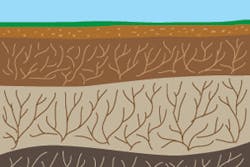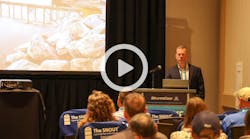Mats, Concrete, Blocks, and Rocks: The Lowdown on Riprap – Part 2
In California, the Department of Public Transportation (Caltrans) sets specifications for using hard armor. Rock used for slope protection should exhibit stability, durability, and consistency. It should meet the specifications of the Army Corps of Engineers or Caltrans, with the supplier having no rejected loads due to any inferior materials. The other specification, of course, is availability. To be a good selection, the material always should be locally available when it’s needed.
If the project engineer decides to use rock rather than other riprap alternatives, a good rock for stabilization projects is either crushed stone or angular rock. Angular or irregular edges offer a greater chance of the rock later providing interlocking qualities. Once the rocks settle and interlock, soil can be trapped and actually help stabilize the structure. Round stones or cobblestones are not recommended for erosion control. Round stones allow a higher degree of slippage when wet and tend to wash out on slopes greater than 1:2, allowing degradation of the entire project.
Coordinating public agencies in California specify that riprap meet Section 72 of the Caltrans Standard Specifications. The standards set limits for size or gradation, apparent specific gravity, and absorption and durability index. The appropriate riprap materials show test results that meet these standards. Caltrans identifies 11 different sizes: 8-ton, 4-ton, 2-ton, 1-ton, _-ton, Light, and No. 1, No. 2, or No. 3 backing. Additionally, two specific placement methods are specified, depending on size and placement mechanism. Basically one method requires setting individual stones (usually large boulders), while the other allows for dumping or dozing the material.
Alternatives to Riprap
As with many other commodities, the affordability of rock is based on availability of rock. For many states, a rock quarry is inaccessible, making the use of rock on projects cost-prohibitive. Some of those same states might have rock available, but it is of poor quality and cannot be considered for use as hard-armor revetment.
For this and other reasons having to do with performance, aesthetics, and life cycle cost benefit, other forms of hard armor serve as alternatives in today’s arsenal of engineered revetment solutions. Two such alternatives, ArmorFlex articulating concrete block mats (ACBs) and A-Jacks armor units, have gained widespread acceptance within the engineering community. Armortec, headquartered in Bowling Green, KY, markets both products.
ArmorFlex fabricated mattress is installed by lifting the system into position by means of a spreader bar. Thousands of square feet of product can be placed in a short time. Popular ACB uses are open-flow channels, shoreline protection, dam overtopping, and pipeline protection as well as drainage ditches and reservoir slope protection. The mats can be seeded and vegetated to provide a pleasing “green” hard-armor solution that many property owners, state and federal agencies, and engineers favor. Equally important, ArmorFlex needs no maintenance, which characteristically has been the Achilles heel of rock riprap.
A-Jacks provide an alternative to riprap where streambank stabilization is needed, especially for urban stormwater runoff and other high velocity flows. A-Jacks units have a two-part component design that interlocks into a highly permeable matrix and serves to stabilize the toe of streams; bioengineering techniques can be used on the remaining slope. A-Jacks also are used on coastal breakwaters and jetties instead of rock as wave attack protection.
Rock Riprap in Action: Projects Across the US
Once the environmental engineers have decided which types of reinforcement to use, the job of purchasing, moving, and placement begins. In the case of Kinkaid Lake in Illinois, moving tons of rock to the eroding beach was only one of the challenges, reports Scott Martin, the district conservationist with the Natural Resources Conservation Service (NRCS) there. After trying vegetative plantings, only to have beavers chew them down, Martin says the NRCS decided to use rock riprap to build up a berm around the area.
The US Forest Service and NRCS, along with the Kinkaid Lake Conservancy District, own the land. The managing agencies teamed up to provide various grants and funded the project. Recommendations for rocks weighing between 50 and 150 pounds each came from a streambank specialist working with the NRCS. The challenge not only was to transport the rocks but also to find the equipment to place them, relates Martin.
“Other alternatives, such as the baskets, were more expensive,” he points out. “You have to put them in place and then they are still filled with rock.”
The project team decided to use quarried rock that came out with irregular shapes and provided for the desired effect of interlocking once the pieces settled in. In addition, says Martin, they used a 12-in. piece of mat material under the rocks to prevent them from sinking into the sand and moving to the water’s edge. The rocks were floated out to the beach area along with a trackhoe to help move the rocks into place. The riprap was placed 20 ft. from land to create a moat affect.
“The land slopes are loess soils and stand up vertically,” Martin describes. “The pounding action of the waves eats at the toe of the undercut. Eventually the slope will fall in and create about a two-to-one slope area, and on the inside there it creates a little ecosystem of its own. There’s already a lot of frogs in there.”
The project at Kinkaid Lake used approximately 1.3 tons of riprap per foot and stabilized more than 1,500 feet of shoreline. The project was funded by an $80,000 grant from the Conservation 2000 Funds, which is administered by the Illinois Department of Natural Resources. The Kinkaid Reed’s Creek Conservancy District and the Kinkaid Area Watershed Project donated an additional $4,000 to the project. The project was sponsored by the Jackson County Soil and Water Conservation District and the Shawnee Resource Conservation and Development Area. The US Department of Agriculture and NRCA provided the technical assistance.


